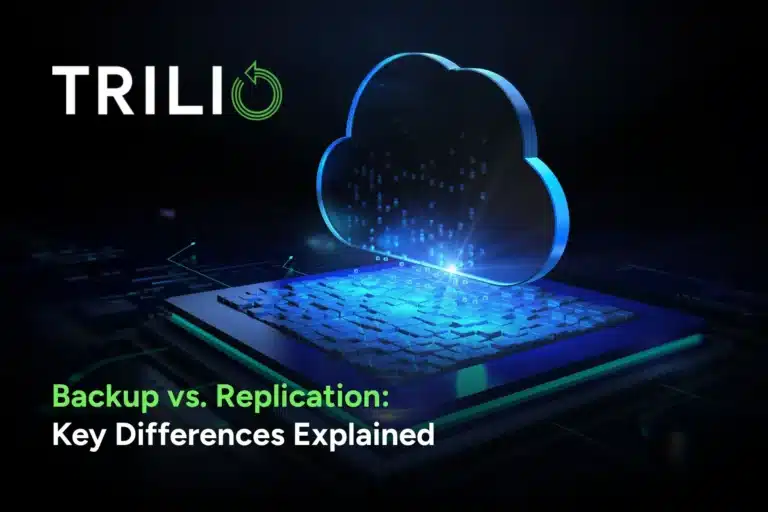Protecting your business-critical data and applications requires understanding two essential strategies: high availability and disaster recovery. While both aim to keep systems operational, they serve distinct purposes and operate on different timelines. This article explains these key differences, provides implementation best practices, and showcases advanced solutions that combine these crucial strategies. You’ll gain practical insights to strengthen your organization’s data protection and business continuity plans. Get ready to enhance your company’s resilience and ensure seamless business continuity.
Mastering High Availability vs. Disaster Recovery: Essential Knowledge for IT Resilience
Defining High Availability
High availability (HA) is an essential system design approach that ensures consistent operational performance, particularly focusing on uptime. HA systems are built to achieve impressive uptime levels, often reaching 99.999% (“five nines”), which translates to an incredibly low downtime of just 5.26 minutes per year. These systems are engineered to run continuously for extended periods without failing, providing reliable and uninterrupted service.
Explaining Disaster Recovery
Disaster recovery (DR) is a comprehensive set of policies, tools, and procedures designed to recover or maintain critical technology infrastructure and systems after a significant disruption. DR plans are more extensive, focusing on restoring data and essential systems following catastrophic events, which may involve longer periods of downtime.
Key Objectives of Each Approach
While both HA and DR aim to maintain business continuity, they have distinct objectives. HA focuses on preventing disruptions, while DR prepares for worst-case scenarios. High availability is about minimizing downtime during regular operations, providing fault tolerance and automatic failover while ensuring continuous access to services and data. Disaster recovery deals with restoring operations after major disruptions, protecting against data loss and corruption, and enabling business continuity during catastrophic events.
A study by the Disaster Recovery Preparedness Council revealed that 73% of companies are inadequately prepared for disasters, emphasizing the need for strong DR planning alongside HA measures. Mastering high availability and disaster recovery concepts will better equip you to protect your organization’s data and ensure business continuity when facing various challenges. Remember: the key is to strike a balance between preventing disruptions and preparing for potential disasters.
Comparing High Availability and Disaster Recovery Approaches
Time Frames: Response and Recovery
High availability and disaster recovery function on very different schedules. HA systems strive for almost instant reactions to failures, often measured in mere seconds or even milliseconds. For example, a cluster of load-balanced web servers might switch to a backup server in milliseconds after detecting a main server failure. In contrast, DR processes typically involve longer recovery periods, which can span from several hours to multiple days, depending on how severe the incident is and how complex the affected systems are.
Infrastructure Requirements
The infrastructure needed for HA and DR also varies greatly. HA setups usually demand redundant hardware, software, and network parts within one data center or across several nearby sites. This could include clusters of servers, backup power supplies, and multiple network connection paths. DR infrastructure, however, often relies on distant backup locations, systems that copy data, and thorough backup solutions capable of restoring entire IT setups.
Cost Considerations
HA and DR have different financial impacts. High availability solutions often come with higher initial costs due to the need for redundant, always running systems. A study by IDC discovered that unexpected downtime can cost organizations up to $250,000 per hour, which justifies investing in HA for crucial systems. DR costs can range widely depending on the chosen approach, from relatively cheap cloud-based backup options to expensive hot sites that mirror the main environment. The key is finding a balance between potential downtime costs and the investment in protective measures.
Implementing High Availability and Disaster Recovery
High Availability Best Practices
Organizations aiming for high availability should prioritize the elimination of single points of failure. This requires implementing redundant hardware, load balancers, and failover mechanisms. Utilizing multiple web servers behind a load balancer ensures uninterrupted service even when one server experiences issues. Consistent maintenance and monitoring play a key role in identifying and addressing potential problems before they lead to downtime. Automating failover processes can substantially reduce recovery time and lessen the chances of human error.
Disaster Recovery Planning Essentials
A ZDNet report reveals that 40% of businesses never reopen after a disaster, underscoring the importance of robust DR planning. Effective planning begins with a comprehensive risk assessment and business impact analysis. It’s essential to pinpoint critical systems and data and then establish recovery time objectives (RTOs) and recovery point objectives (RPOs) for each component. Developing detailed recovery procedures and ensuring that they undergo regular testing and updates is crucial. Off-site backups are indispensable, with cloud-based solutions offering scalability and cost-effectiveness. To implement these plans effectively, leveraging nearshore backend development can provide specialized expertise and support, ensuring systems are resilient, maintainable, and quickly restorable in the event of a disaster.
Integrating Both Strategies
Combining high availability and disaster recovery creates a thorough resilience strategy. HA techniques should be applied to mission-critical systems requiring constant uptime, while DR plans offer broader protection against major disruptions.
Cloud-native solutions can effectively bridge the gap between HA and DR, providing features such as geo-redundancy and automated failover across regions. Consistent testing of both HA configurations and DR procedures ensures that they function as intended when needed. Integrating these approaches allows organizations to achieve immediate fault tolerance and long-term recovery capabilities, greatly enhancing their overall IT resilience.
To effectively implement both strategies, consider these practical steps:
- Evaluate your organization’s specific needs and risk tolerance.
- Identify critical systems and data requiring high availability.
- Create a detailed disaster recovery plan, including off-site backups.
- Regularly test both HA configurations and DR procedures.
- Invest in technologies supporting both HA and DR, such as cloud-based solutions.
Advanced Solutions for Continuous Data Protection
The Role of Continuous Recovery in IT
Businesses now depend heavily on real-time data and services that never sleep. This means old-school backup methods just don’t cut it anymore. Continuous recovery has stepped up to the plate, offering data protection and recovery that’s almost instantaneous. This approach captures changes to data and applications non-stop, creating a steady stream of recovery points that can be tapped into at any given moment.
Trilio's Continuous Recovery & Restore
Trilio’s Continuous Recovery & Restore takes data protection up a notch, especially for Kubernetes and cloud-native setups. Unlike traditional backup systems that rely on periodic snapshots, this clever approach keeps an eye on events and grabs incremental changes as they happen. This means you can roll back to the most recent stable state in mere seconds, cutting downtime and data loss to almost nothing.
Benefits for Kubernetes and Cloud-Native Environments
For companies running critical workloads in fast-paced, containerized environments, Trilio’s solution brings some serious perks to the table:
- Near-zero downtime: Instant restoration of apps and services without complicated manual fiddling
- Scalability: Expands alongside cloud-native applications and plays nice with multi-cloud setups
- Native integration: Fits like a glove with Kubernetes, tapping into advanced backup and restore features
- Comprehensive protection: Guards against data loss, corruption, and cyber nasties
Implementing continuous recovery solutions like Trilio’s allows businesses to reach new heights of resilience. Its approach bridges the gap between high availability and disaster recovery, offering both quick fault tolerance and solid long-term protection. As more organizations jump on the cloud-native bandwagon, solutions providing this level of continuous data protection will become essential for keeping the business running smoothly and meeting tough uptime demands.
Conclusion
Finding the sweet spot between high availability and disaster recovery is essential for companies looking to protect their operations and data. High availability aims to reduce downtime during normal operations, while disaster recovery prepares for major disruptions. Implementing both approaches effectively creates a strong defense against various IT infrastructure threats.
Advanced solutions like Trilio’s Continuous Recovery & Restore combine the advantages of high availability and disaster recovery, offering near-instant data protection and recovery. This is particularly useful in dynamic Kubernetes and cloud-native environments.
As businesses increasingly depend on real-time data and services, adopting comprehensive data protection strategies becomes more critical. To learn how Trilio’s innovative solutions can improve your organization’s resilience and ensure business continuity, schedule a demo and start strengthening your data protection strategy today.
FAQs
How do high availability and disaster recovery impact business continuity?
High availability systems aim to reduce downtime during normal operations, often resolving minor issues within moments. Disaster recovery, however, tackles major incidents and may take considerably longer to restore full functionality. While high availability ensures smooth daily operations, disaster recovery provides a backup plan for severe events. Both strategies are essential for maintaining continuous business operations and safeguarding data.
What are the key differences in implementation between high availability and disaster recovery?
High availability typically uses redundant hardware, load balancers, and quick failover systems, often within a single data center or nearby locations. Disaster recovery setups usually involve off-site backups, data replication, and detailed plans for rebuilding entire IT environments.
Can high availability replace the need for disaster recovery planning?
High availability cannot completely eliminate the need for disaster recovery planning. Although high availability systems help prevent minor disruptions, they may fall short during major catastrophes like natural disasters, large-scale cyberattacks, or widespread power failures. Disaster recovery planning offers broader protection against these significant events. A robust IT resilience strategy should include both high availability for routine operations and disaster recovery for extreme situations. This dual approach ensures immediate fault tolerance and long-term recovery capabilities.
How do cloud-native solutions bridge the gap between high availability and disaster recovery?
Cloud-native solutions offer features that blend aspects of high availability and disaster recovery. These platforms provide benefits such as geographic redundancy, automatic failover across regions, and flexible backup options. For instance, containerized applications running on Kubernetes can be easily duplicated across multiple cloud regions, offering both high availability and disaster recovery capabilities. Cloud-native services also enable ongoing data protection and quick recovery, further reducing the distinctions between high availability and disaster recovery strategies.
What factors should be considered when balancing high availability and disaster recovery investments?
Key factors include the importance of various systems and data, tolerable downtime for different business processes, potential financial losses from disruptions, and legal requirements. It’s crucial to compare the costs of implementing and maintaining high availability systems against the potential consequences of extended downtime. Similarly, the investment in disaster recovery should be evaluated against the risks of data loss and lengthy business interruptions. A thorough risk assessment and business impact analysis can guide the optimal distribution of resources between high availability and disaster recovery strategies.




